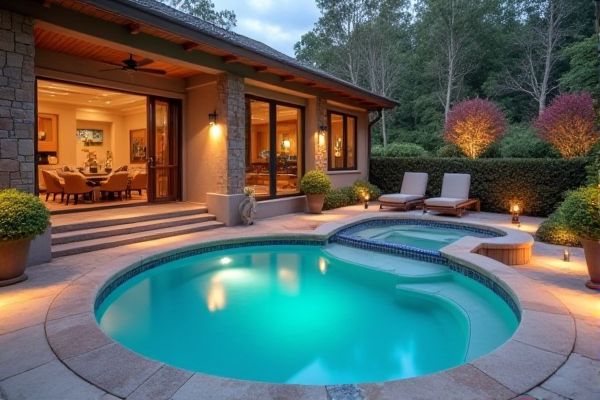
A hot tub offers warm, soothing water ideal for relaxation and hydrotherapy, while a plunge pool provides a cooler, refreshing experience perfect for quick dips and exercise. Discover which option best suits Your lifestyle and wellness needs by reading the rest of this article.
Table of Comparison
| Feature | Hot Tub | Plunge Pool |
|---|---|---|
| Purpose | Relaxation, hydrotherapy | Cooling off, quick dips |
| Water Temperature | Warm to hot (100degF-104degF) | Cold to cool (50degF-70degF) |
| Size | Seats 4-8 people, compact | Small pool, larger than hot tub |
| Hydrotherapy Jets | Yes, integrated jets | No jets, still water |
| Installation | Above or in-ground | Mostly in-ground |
| Maintenance | Regular water treatment, filter cleaning | Pool-level maintenance, filtration |
| Cost | Moderate to high ($3,000-$15,000) | Higher initial cost ($10,000-$30,000) |
| Energy Use | Heated constantly, higher energy consumption | Usually unheated or cooled, lower energy use |
Introduction to Hot Tubs and Plunge Pools
Hot tubs offer warm, bubbling water designed for relaxation and hydrotherapy, often equipped with jets that target muscle tension. Plunge pools provide a compact, chilled water experience ideal for cooling down and invigorating the body, especially after exercise. Choosing between a hot tub and plunge pool depends on whether you seek soothing heat or refreshing cold therapy for your home wellness routine.
Key Differences Between Hot Tubs and Plunge Pools
Hot tubs feature heated water maintained around 100-104degF, providing therapeutic warmth and hydrotherapy jets for muscle relaxation, whereas plunge pools are cooler, typically 50-70degF, designed for refreshing cold immersion and exercise. Hot tubs are usually smaller with built-in seating and massaging jets, while plunge pools offer a larger swimming area suitable for low-impact workouts and cooling off. Maintenance for hot tubs involves managing chemical balance and heating elements, whereas plunge pools require less heating but focus on filtration and water circulation.
Health Benefits: Hot Tub vs Plunge Pool
Hot tubs provide therapeutic heat and massage jets that help relieve muscle tension, improve circulation, and reduce stress, making them ideal for relaxation and recovery. Plunge pools offer cold water immersion benefits, such as reducing inflammation, boosting metabolism, and enhancing muscle recovery post-exercise. Both options support cardiovascular health, but hot tubs excel in promoting relaxation while plunge pools are preferred for invigorating cold therapy.
Installation Requirements and Costs
Hot tubs typically require minimal installation with a level surface and access to a standard electrical outlet, making them cost-effective and quick to set up. Plunge pools demand more extensive installation, including excavation, plumbing, and electrical work, driving costs significantly higher due to the permanent nature and larger size. Budget considerations should factor in not only upfront installation expenses but also ongoing maintenance and utility usage for both hot tubs and plunge pools.
Maintenance and Upkeep Comparison
Hot tubs require regular water treatment, including frequent chemical balancing and filter cleaning every 1-2 weeks to prevent bacteria buildup. Plunge pools demand more intensive maintenance, involving larger volumes of water, consistent circulation, and bi-weekly cleaning of filters and pool surfaces. Both feature energy costs for heating, but plunge pools often incur higher expenses due to their size and water volume.
Energy Efficiency and Running Costs
Hot tubs generally consume more energy due to their constant heating and powerful jets, leading to higher running costs compared to plunge pools, which require less frequent heating and circulation. Plunge pools benefit from larger water volumes that maintain temperature longer, reducing energy use and operational expenses. Your choice will impact long-term energy efficiency, with plunge pools often providing a more cost-effective solution for regular use.
Space Considerations: Which Suits Your Yard?
Hot tubs typically require less space, making them ideal for smaller yards or patios, while plunge pools demand a larger footprint suitable for more expansive outdoor areas. The compact design of hot tubs allows for easier integration into tight spaces, often with built-in seating and jets for hydrotherapy. Plunge pools offer more swimming freedom and can incorporate additional landscaping features, providing a versatile and visually appealing option for spacious yards.
Year-Round Usability and Comfort
Hot tubs provide consistent year-round usability with heated water that ensures comfort during colder months, making them ideal for relaxation regardless of outdoor temperatures. Plunge pools, while excellent for cooling off in warmer seasons, may require additional heating systems to maintain comfortable temperatures in winter. Your choice depends on whether you prioritize thermal comfort and extended use throughout the year or seasonal cooling benefits.
Design, Size, and Customization Options
Hot tubs feature ergonomic seating with jets designed for hydrotherapy, typically compact with sizes ranging from 4 to 7 feet in diameter, offering extensive customization including lighting, jet types, and materials. Plunge pools emphasize a minimalist design with deep, small footprints around 6 to 10 feet in length, allowing personalization in shape, depth, and filtration systems for a refreshing cold-water experience. Both options cater to different relaxation needs and space constraints, with hot tubs prioritizing warmth and massage and plunge pools delivering cool immersion and exercise flexibility.
Choosing the Right Option for Your Lifestyle
Hot tubs offer warm, soothing water ideal for relaxation and muscle therapy, while plunge pools provide cooler water for invigorating exercise and quick refreshment. Your lifestyle priorities, whether you seek therapeutic benefits or a refreshing swim, will determine the best choice. Consider space, maintenance, and intended use to select a hot tub or plunge pool that aligns with your daily routine and wellness goals.
 homyna.com
homyna.com